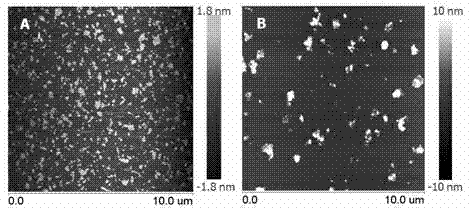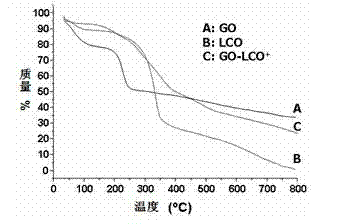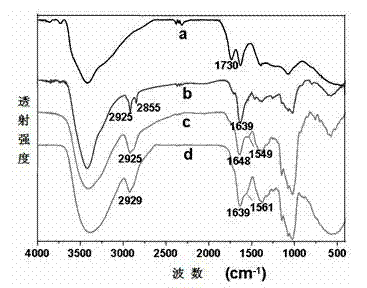Common carrier material for targeting anticancer drug and gene and preparation and application
An anti-tumor drug and carrier material technology, applied in the field of targeted anti-tumor drugs and gene co-carrying carrier materials, can solve problems such as multi-drug resistance and side effects, achieve reduced toxic side effects, high stability, and avoid mass release Effect
- Summary
- Abstract
- Description
- Claims
- Application Information
AI Technical Summary
Problems solved by technology
Method used
Image
Examples
Embodiment 1
[0046] The first step: synthesis of graphene oxide material, the preparation process can refer to (ACSNano, 2008, 2,463-470); the core of this step is to obtain graphene oxide material. Similarly, other methods can also be used to obtain graphene oxide materials.
[0047] Step 2: Preparation of lactose acylated chitosan:
[0048] Lactobionic acid 0.2671 g, 1-ethyl-3(3-dimethy amino-propyl) carbodiimide (EDC) 0.1715 g, N-hydroxy succinimide (NHS) 0.1030 g dissolved in 5 mL of distilled water, dissolved by ultrasound, activated by electromagnetic stirring for 1 hour . Weigh 1 g of purified chitosan, dissolve it in 3 mL of distilled water, dissolve it by ultrasound, mix it with activated lactobionic acid, add triethylamine to adjust the pH to 8-9, and react with electromagnetic stirring for 48 hours. The system is revolved to remove the solvent, the concentrate is passed through a dextran gel column, the yellow solution that flows out is collected, and the product is concentrated an...
Embodiment 2
[0066] The first step: synthesis of graphene oxide material, the preparation process can refer to (ACSNano, 2008, 2,463-470); the core of this step is to obtain graphene oxide material. Similarly, other methods can also be used to obtain graphene oxide materials.
[0067] Step 2: Preparation of folic acid and chitosan conjugate:
[0068] 109.4 mg of folic acid, 95.85 mg of 1-ethyl-3(3-dimethy amino-propyl) carbodiimide (EDC), and 57.5 mg of N-hydroxy succinimide (NHS) were dissolved in 10 mL DMSO. After dissolution by ultrasound, it was activated by electromagnetic stirring for 1 hour. Weigh 500 mg of purified chitosan, dissolve it by ultrasound, add 200 μL of triethylamine, and react with electromagnetic stirring at 30-40 ℃ for 72 hours. The system was revolved to remove the solvent, 80 mL of acetone was added for precipitation, and the precipitate was washed twice with acetone. The precipitate was dissolved in water, centrifuged for 5 minutes (1000 rpm), and the supernatant was...
Embodiment 3
[0085] The first step: synthesis of graphene oxide material, the preparation process can refer to (ACSNano, 2008, 2,463-470); the core of this step is to obtain graphene oxide material. Similarly, other methods can also be used to obtain graphene oxide materials.
[0086] Step 2: Preparation of folic acid and chitosan conjugate:
[0087] 109.4 mg of folic acid, 95.85 mg of 1-ethyl-3(3-dimethy amino-propyl) carbodiimide (EDC), and 57.5 mg of N-hydroxy succinimide (NHS) were dissolved in 10 mL DMSO. After dissolution by ultrasound, it was activated by electromagnetic stirring for 1 hour. Weigh 400 mg of purified chitosan, dissolve it by ultrasound, add 200 μL of triethylamine, and react with electromagnetic stirring at 30-40 ℃ for 72 hours. The system was revolved to remove the solvent, 80 mL of acetone was added for precipitation, and the precipitate was washed twice with acetone. The precipitate was dissolved in water, centrifuged for 5 minutes (1000 rpm), and the supernatant was...
PUM
 Login to View More
Login to View More Abstract
Description
Claims
Application Information
 Login to View More
Login to View More - R&D
- Intellectual Property
- Life Sciences
- Materials
- Tech Scout
- Unparalleled Data Quality
- Higher Quality Content
- 60% Fewer Hallucinations
Browse by: Latest US Patents, China's latest patents, Technical Efficacy Thesaurus, Application Domain, Technology Topic, Popular Technical Reports.
© 2025 PatSnap. All rights reserved.Legal|Privacy policy|Modern Slavery Act Transparency Statement|Sitemap|About US| Contact US: help@patsnap.com



